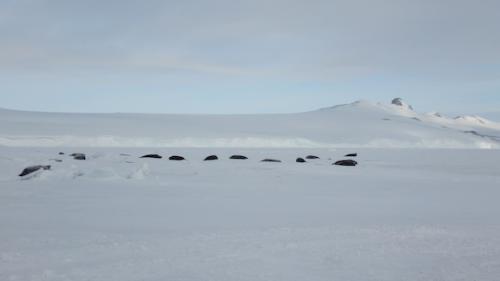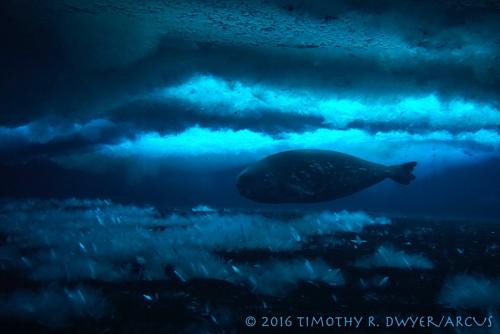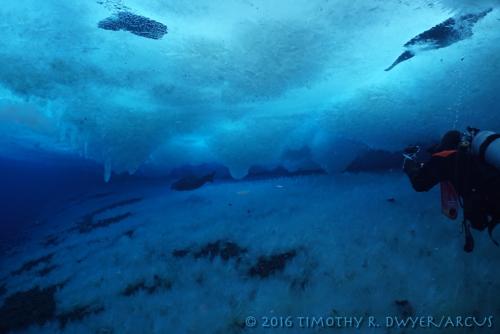After two weeks in Antarctica, the enormous and rotund Weddell seal (Leptonychotes weddellii) is the first warm-blooded animal we've encountered. With the approaching southern hemisphere summer, their numbers seem to be multiplying rapidly. Looking out onto the sea ice from the Crary Lab, more and more small dark dots appear, sharply contrasting the Antarctic landscape. As a high school student I remember reading about their impressive diving ability (2300ft/700m for up to 80 minutes) and the fascinating physiological adaptations that allow them to reach such crushing depths. As a high school teacher I'm experiencing them in person under the Antarctic ice. While the Antarctic Treaty prevents us from approaching the seals, we can certainly observe in the course of our scientific activities.
 Weddell seals rest near a sea ice hole.
Weddell seals rest near a sea ice hole.
Weddell seals are the only marine mammals present year round in McMurdo Sound. They manage to eke out an existence by keeping holes in the sea ice open, maintaining access to the rich food resources beneath. Awkward above the ice, the seals are graceful if ungainly below it, gliding through the brash ice much like a blimp glides through the clouds. They typically hold their breath for up to 20 minutes and their hunting range is limited by the number of breathing holes they can move between. These are often located close to land where sea ice cracks are much more frequent.
 Seals can venture within a 20 minute breath-hold swim of open ice holes to hunt for food.
Seals can venture within a 20 minute breath-hold swim of open ice holes to hunt for food.
Spring is the season when females give birth to their pups, nursing them on the ice for around two weeks before returning to the water to feed. In a few weeks, when the females have weaned their young, the breeding season will begin and males will begin to compete for territory and mates. Some aspect of this annual ritual was clearly underway a few days ago when, resting in our dive hut between dives, the head of a seal popped up through one of our dive holes! For several minutes we watched as he forcibly exhaled a breath, looked back down the hole beneath him, and then brought his head back up for another breath. This behavior isn't surprising when you consider that male seals will often bite the fins of rival males when they stop to breathe. Our seal was nicked and gashed in several places on his head and neck, an indication that he'd been fighting, and a sign that breeding season would be here soon.
 A scientific diver takes the opportunity to observe, but not approach, a seal swimming nearby.
A scientific diver takes the opportunity to observe, but not approach, a seal swimming nearby.
I'm looking forward to seeing seal pups in the water in the coming weeks. While we can't approach them or interact if they approach us, we can watch and listen. Additionally, the territorial vocalizations of male seals will increase as the breeding season picks up in November. The underwater chirps, barks, and trills of unseen Weddell seals contribute to the otherworldly experience that is diving in Antarctica.
For everything you ever wanted to know and more about Weddell seals, visit PolarTREC teacher Alex Eilers' excellent journals.


Comments